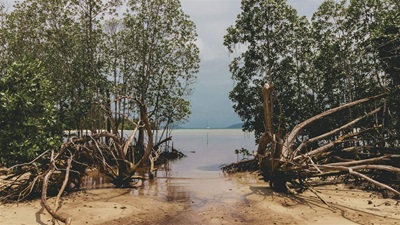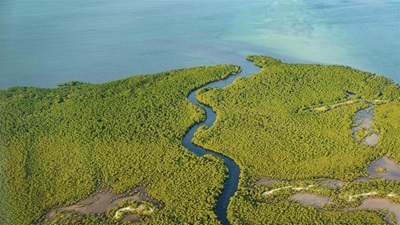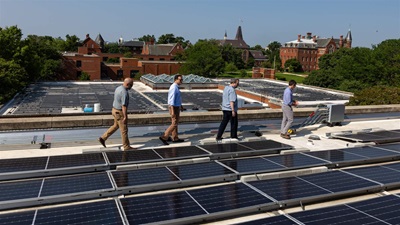Scientist Discusses Her Mission to Protect Jamaica’s Mangroves
How mapping and assessing carbon storage in coastal wetlands will help inform conservation actions
July 26 is International Day for the Conservation of the Mangrove Ecosystem, a moment to celebrate one of the most essential coastal ecosystems on the planet.
In Jamaica, mangroves are more than just a line of defense against rising seas and stronger storms. They are also lifelines for biodiversity and local livelihoods, and they draw down carbon dioxide from the atmosphere and sequester the carbon in soils. Mangroves’ dense root systems act as natural barriers, absorbing wave energy and significantly reducing the effects of floods and storm surges. At the same time, mangroves are nurseries for countless marine species that fuel ocean biodiversity and support local fishing, tourism, and other vital economic activity. These ecosystems also store up to five times as much carbon as terrestrial forests, which, if left undisturbed, can remain locked away for millennia.
The Pew Charitable Trusts caught up with Jamaican researcher Le’Anne Green, an environmental scientist with six years of experience studying seagrass ecosystems and a project manager at the Centre for Marine Sciences at the University of the West Indies (UWI), Mona. Green is keen to ensure that her country’s mangroves are effectively managed and protected. Her work is helping to quantify the carbon stored in these coastal forests and making the case that conserving them isn’t just good ecology, but also smart policy.
This interview has been edited for length and clarity.
What influenced you to study marine sciences?
My heritage definitely played a major part in my decision to pursue marine sciences. It’s really hard not to feel appreciation for the environment when you live on an island. I was always one to go outside and play outdoors; we had a lot of pets and a big yard to run around. My parents would take my sister and I to the countryside, which you can imagine wasn’t much fun if you stayed inside. So being in nature and around animals was the norm for us.
Nature really does become a part of you and being able to take a few steps outside and explore was all it took for me to want to learn more.
What else sparked your interest in this field? Was there a moment or person that set you on this path?
Growing up, I never thought of pursuing law or business. I thought I’d become a wildlife conservationist or veterinarian, anything to do with the outdoors or animals. That is, until I saw my older sister going diving for work and realizing her dream of becoming a marine biologist and how much fun she had. That really pushed me to think that you don’t have to follow the crowd and do something conventional—you could do what you love as your job. And she seemed much happier than most people when she left for work. Plus, my parents never stopped us from doing what we wanted to do for work. They were very supportive.
Were there other role models who shaped your passion for marine science, anyone you admired growing up?
For younger environmentalists, it’s hard to think of pursuing a career in nature without thinking of people like Steve Irwin and Jeff Corwin on Animal Planet. Sure, growing up on an island is great, but you would see these guys on TV doing the most incredible things, and their enthusiasm and passion would be so contagious. Sir David Attenborough would take me to places I could never dream of going on the Discovery Channel. I’m sure I lived most of my life through them.
Do you and your sister collaborate professionally?
Yes, in fact, my sister and I have collaborated on a Pew-funded project, conducted in partnership with The Nature Conservancy and the University of West Indies (UWI), to assess carbon stock in Jamaica’s seagrass and mangroves. Whether it was coordinating site visits from the Port Royal Marine Laboratory, where she is the chief scientific officer; helping with fieldwork herself; or offering help from staff members, she has always been willing to be involved where possible. Likewise, if she needs help on any project or surveys, I’m always there to help.
Your master’s thesis focused on marine and terrestrial ecosystems. Did you know then that your career would be rooted in coastal wetlands research and conservation, or did that unfold later?
At the time I was doing my master’s degree, I was actually still deciding! Both worlds were catching my attention. It wasn’t until I was nearing the end of my degree and we had an assignment which required us to start focusing on a research project that led me to the idea of looking at blue carbon—the carbon captured and stored in coastal and marine ecosystems—in seagrass meadows. My lecturers really liked my proposal and started using it as an example. So needless to say, I became invested. Then reading all the material and learning that there was little work being done on seagrass in Jamaica, I saw it as a chance to make my mark.
As a woman in science, how important is representation and having ownership over your work?
Now I think it’s very important to see female scientists in action and in positions of leadership as STEM has historically been male dominated. But when I was younger, I never thought of how important female representation was. As I mentioned, my role models were Steve Irwin, Jeff Corwin, and Sir David Attenborough—all men.
If I were to really think about female scientists that had some influence on my early life growing up, most of them were fictional, like Laura Dern’s role in “Jurassic Park.” It wasn’t until my teens and in university and later, that I learned about real-life women in the sciences: Dr. Jane Goodall and her work with chimpanzees; and Professor Mona Webber’s contribution to marine sciences in Jamaica; and “Her Deepness,” Dr. Sylvia Earle.
So yes, recognition and ownership for our work is very important and maybe one day I will be who young girls look up to.
What’s your favorite part of your job—teaching, research, or fieldwork?
It’s hard to assign a favorite to be honest. I love fieldwork, but I also enjoy teaching students how to carry out the field methodologies. On the other hand, the research becomes interesting because you’ve compiled all of the data, and it’s now up to you and knowing how ecosystem interactions work to figure out the answer to the question you were asking at the start.
I also find working on data sheets and their interpretations therapeutic. But when it all boils down, if I have to choose a favorite, seeing the team working harmoniously in the field and enjoying themselves while fine-tuning their skills might just be it.
Do you have a favorite coastal ecosystem?
I do! It’s no shock though; seagrasses are my favorite coastal ecosystem.
What makes seagrasses special to you?
There is so much life in seagrass meadows. Every time you go, you see something different. It’s funny, I didn’t know how passionate I was about seagrasses until I was taking seagrass soil cores in Negril for a few weeks and saw the seagrass bed flowering! This is something that most scientists don’t get a chance to see or only see once or twice in their lifetime. I might have spent 10 minutes just staring at it. As soon as I got back on land, I messaged Professor Webber immediately and sent her pictures. I called everyone over to see—and I might’ve taken a soil core that captured it.
You’ve played a big role in some recent conservation and carbon stock research in Jamaica. How did you first get involved in that work?
My interest in blue carbon started during my master’s research. After finishing my degree, I was contacted by a consultancy agency that wanted to include carbon stocks in their environmental impact assessments and environmental reports as a way to elevate the importance of coastal ecosystems and the role that they play in carbon capture. That’s where my involvement and expertise over time stemmed from.
Has working on the Pew/The Nature Conservancy/UWI blue carbon research project taught you anything new about the ecosystems, the science, or policy?
It has. Before the project, I was mainly focused on seagrasses. And while I knew about the relationship between seagrass and mangrove ecosystems and the influence that mangroves have on seagrasses, I wasn’t as familiar as I am now with how much information you need to understand mangrove blue carbon or the time required in the field to collect all that data. I mean, I have developed a very deep respect for the amount of work it takes to get this information. I also got a glimpse into the world of policy and how important it is for policy to be backed by good science, particularly for the inclusion of seagrass and mangroves into Jamaica’s nationally determined contribution to the Paris Agreement—the country’s climate action plan submitted every five years to the United Nations Framework Convention on Climate Change.
Looking ahead, what are your hopes for the seagrass and mangrove carbon assessments and for the future of conservation in Jamaica?
I have many hopes for what we have done in the blue carbon project. The team worked very hard, and to this day we say that “if you could survive a day of fieldwork, you could survive anything.” I would like the assessments we have done and the results we have produced to highlight the importance and role of these ecosystems and to continue to influence conservation efforts nationwide and inspire the continuation of blue carbon science, not only for Jamaica but regionally. Jamaica, like many other small island developing states, relies heavily on the benefits that marine ecosystems provide, including their role in major economic sectors, such as tourism, agriculture, and fisheries, that most of our population depends on. So it really is our duty to put in place precautionary measures that protect and preserve mangroves and seagrasses for future generations.











